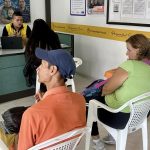On November 4, Russia celebrated its main national holiday, the Day of Unity of the People (Den Narodnogo Edinstva), which commemorates the events of 1612, when victory was declared over the Polish invaders and the reign of the Tsar of Muscovy was entrusted to the new Romanov dynasty, which replaced that of the old Ruriki. The war rhetoric of the moment cannot fail to underline such a dark and controversial event, which is considered the end of the “turbid period” in the transition between the 16th and 17th centuries.
That change of era put an end to the dream of the “Third Rome” of the first Tsar Ivan the Terrible, who had dominated the scene for fifty years of reign, ruining everything with his autocratic and police madness, and with his senseless war campaigns to the territories baltics It is a phase in many respects similar to the one we are experiencing today, after the end of the 20th century Soviet empire and 30 years of “turbidity” in the new Russia of Yeltsin and Putin. Various figures from that period can be compared to them. Those dark old times developed around the contradictions of the tsar-regent Boris Godunov, a descendant of the Oprinina, Ivan’s imperial guard and mother of all Russian political police, reaching the KGB or Putin’s FSB.
Godunov is a crucial figure in Russian history, to the point of having inspired poems and great artistic and musical works. He was a dictator and a reformer, a visionary and a city builder. But he too was accused of infamous betrayals and abandoned by all, until he died of too much food and alcohol on the terraces of the Kremlin – a bit like Yeltsin and a bit like Putin now. Boris had the intuition to elevate the Muscovite ecclesiastical seat to the rank of patriarchate, for which he forced the Patriarch of Constantinople Jeremiah II to sign the decree creating the “Third Rome” in 1589, after holding him as a gold hostage in the Kremlin for Several months.
Following this decision, the Russian 17th century was the century of the symphony between throne and altar, a symbiosis of politics and religion that would only be repeated in similar tones in Putin’s Russia. Later the patriarchy was abolished by Peter the Great in the early 18th century, and the Church remained subordinate to the empire during the following tsarist centuries and also in the Soviet period, which formally restored the role but not the freedom of action of the patriarchs, reduced to the role of “altar boys” of Stalin and Brezhnev. During the turbulent times, however, the figure of the patriarch-martyr Hermogenes was exalted first, who died of hunger in a fortress at the hands of the invading Poles. And then the founder of the new tsarist dynasty emerged, that Fedor Romanov who had been forced to become a monk, also locking his wife in a cell, and who took revenge by assuming Filaret as patriarch, imposing on the throne his son Mikhail , the first tsar of the new era.
For about twenty years, the tsar-son remained subordinate to the patriarch-father, and throughout the century the situation repeated itself, especially with the patriarch Nikon, of whom the current Kirill seems the reincarnation even in facial features. Nikon pretended to be called “lord and monarch” of Russia until he was deposed by Tsar Aleksej, Filaret’s nephew. Before his death, Nikon tried to return to Moscow to proclaim himself “universal pope”, transferring the former patriarchates to the provinces near Moscow. In this he was supported by some Eastern patriarchs who were in exile as a result of the Ottoman Empire.
These and others are the complex and grotesque events taking place in today’s militant Russia, which seeks revenge on the Poles and the West – both of which have been trying by all means to finish off Russia all this time, according to Moscow leaders. To oppose the invaders, inspired by the Kraków Jesuits, were the “people’s armies” of the merchant Kuzma Minin and Prince Dmitry Požarsky. Their figures were immortalized on the monument located in front of the entrance to the Kremlin: with a wave of their arms, they show the invaders the way back. They are the prophets of Russian resistance to all attempts at occupation, from that of the Swedes in the 18th century to that of Napoleon, to the onslaught of Hitler’s armies, so intensely evoked in recent months.
So celebrating the murky memory of the 17th century, the Russians find reason to continue the great defensive war, now effectively bogged down in the late-autumn mud of the annexed areas. By dint of the sacrifice of the “mobilized” people, they resist the reconquest attempts of the corrupt Ukrainians, heirs of the Poles and Jesuits of that time. In reality, the choice of the date of November 4 was quite casual: after the end of the USSR, the great festival of November 7, which commemorated the October Revolution, was suppressed, in an overlapping of calendars that was also very symbolic, in the contradiction endemic to Russian history.
The proximity of both dates made it possible to maintain the custom of the “bridge holiday” at the beginning of November, which not even the post-Soviet Russians had any intention of giving up. In November the first frosts and the first snows usually fall, and the popular custom of greeting the incipient winter also means a dynamic of death and resurrection. Winter, in fact, covers and hides, shuts everyone up at home and takes over the streets, and often leaves no escape for travelers, or simply homeless prisoners of alcohol excesses. The November festival is a farewell, while the arrival of spring in May is the new birth, the greeting of those who return from the dead. This year, more than ever, the traditional calendar coincides with the fears and wishes of reality, in the face of the threat of nuclear catastrophe or the freezing of the perennial war.
It was the leaders of the Orthodox Church, the then Patriarch Aleksij and Metropolitan Kirill, who suggested the “patriarchal” date in the 1990s. Almost as if to imply, once again, that they were the ones who arrogated the right to bless and curse all forms of social and political life. Subsequently, the party absorbed both the imperial pretensions of the “tsar of the people” – as the Romanov monarchs liked to call themselves – and those of the “dictatorship of the proletariat”, in which the people were educated and “mobilized” by the party. Even today, Patriarch Kirill roars against Western moral degradation, which only true Russian Orthodoxy is capable of resisting. And just as in the past the miraculous icon of Our Lady of Kazan was erected against the Poles, today the icon of the Holy Trinity is shown to the people, torn from the Museum of the Tretyakov Gallery in Moscow to remind of the “divine unity” of the throne, the altar and the army.
However, memory is precisely the way to redemption and peace, as the Catholic celebrations of All Saints and the Dead suggest these days. Instead of pointing to past events of imperial glory, it would have been better not to tarnish another symbolic date, that of October 30, when the Day of Remembrance for the Victims of Political Repression, instituted in Yeltsin’s Russia in 1991, used to be commemorated. On that date Soviet dissidents were remembered, but now it was suppressed by the authority of the new dictatorial regime, which in addition to Ukraine, this year has exterminated all alternative voices, suppressing even the association Memorial which was the instrument and voice of the dissidents. It was the dissident leader and Nobel Peace Prize winner Andrei Sakharov who inspired this memoir, when on October 30, 1974 he organized a press conference in his Moscow apartment, to support the hunger strike of some political prisoners imprisoned in the fields of Mordovia and the Perm region.
Since then, October 30 has become an appointment for all humanitarian activists, from the years of persecution to the present, and its cancellation. This year, once again, the “Restitution of names” took place in almost all of Russia, except Moscow. In the Russian capital, even in the Catholic Cathedral of the Immaculate Conception, the local Archbishop, Monsignor Pezzi, forbade the proclamation of the names of Catholic victims of Soviet repression, which are posted on the walls of the church anyway. On October 30, 1988, the association was also founded Memorialwhich the following year, on the same date, united thousands of people in a human chain around the KGB headquarters in Lubjanka, calling for the trial of the “čekist executioners”, the many oppressors of the political police of the USSR.
The Restitution of Names took place for the first time in 2007, in the Moscow wake of the victims of the Solovki, the first forced labor camp of the Lenin era, where the former monastery was located, in the far north. At that time, 420 names were commemorated, and the number increased year by year as the documents of Memorial, until the Putin government ordered the closure of the archives and the censorship of memory. The last public expression of some importance was the inauguration of the “Wall of Grief” (Stena Skorbi) in the prospect Sakharova in Moscow on October 30, 2017, 80 years after the Stalinist terror of 1937. Putin himself intervened on the spot, saying that the repression was a tragedy and a crime, which cannot be justified. Later, evidently, he lost his memory.













